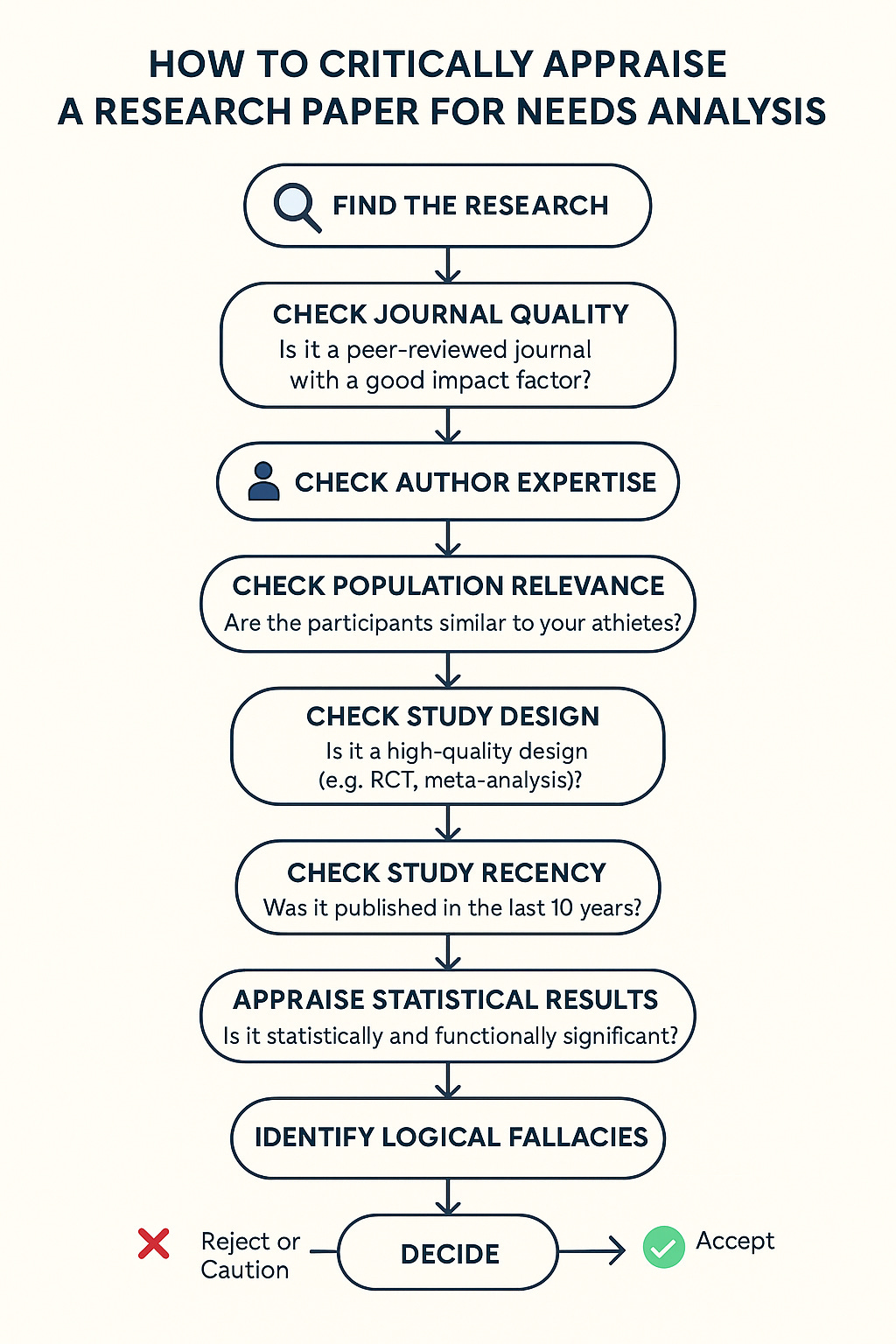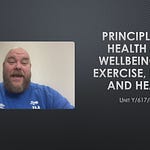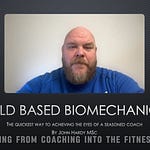This article comes from a section of the new Level 4 Strength and Conditioning Diploma that FASTER has just launched. Although I believe most courses will skip over the section where you have to justify the level of research and evidence needed to make training decisions for a client, I don’t think you should. In fact I think it is harmful.
If you are not an academic it doesn’t matter, in fact sometimes it makes you better at finding and interpreting research for your client, because you approach the evidence without bias.
Effective needs analysis demands disciplined, critical use of research evidence. Fitness Coaches must distinguish correlation from causation, recognise the limitations of p-values, emphasise functional significance, and remain vigilant against logical fallacies. By setting high standards for evidence quality, S&C coaches ensure their practice is defensible, impactful, and ethically robust.
Formal and Informal Methods of Research
Formal MethodsFormal research methods involve structured, systematic investigations that adhere to established scientific protocols.
Key forms include:
Systematic Reviews: Comprehensive, methodical collections and critical analyses of all relevant studies on a particular topic, following predefined eligibility criteria to minimise bias (Moher et al., 2009).
Meta-Analyses: Statistical combinations of results from multiple studies conducted alongside systematic reviews to increase the power and precision of conclusions (Borenstein et al., 2011).
Randomised Controlled Trials (RCTs): Studies involving random assignment of participants into experimental or control groups to test interventions, reducing selection bias and establishing causality (Schulz et al., 2010).
Longitudinal Cohort Studies: Studies that observe a cohort over time, identifying associations and tracking changes, though with less strength in establishing causality (Mann, 2003).
Strengths:
High internal validity and methodological transparency.
Peer-reviewed and statistically robust.
Findings are generalisable when samples are appropriately chosen.
Weaknesses:
Time-consuming and expensive.
May lack ecological validity.
Logistical and ethical challenges, particularly with elite populations.
Informal Methods
Informal methods involve practical, experience-based knowledge gathering, such as:
Expert Interviews
Field Observations
Athlete Feedback
Strengths:
Context-specific and immediately applicable.
Captures nuances not reflected in formal studies.
Weaknesses:
Subject to bias and limited sample sizes.
Lacks peer review and systematic methodology.
Finding and Accessing Quality Research
S&C and Fitness Coaches must proactively seek high-quality research through:
PubMed: A free resource accessing MEDLINE, providing peer-reviewed biomedical and sport science literature.
Google Scholar: A broader academic database including theses, books, and grey literature.
Professional Bodies: Publications from organisations such as BASES, UKSCA, and NSCA provide trusted, up-to-date information.
Scientific Presentations: Conferences, webinars, and YouTube lectures offer access to recent findings.
Social Media: Following respected researchers on platforms such as X (formerly Twitter), Instagram, LinkedIn, and Bluesky can help maintain awareness of emerging trends.
Critical vigilance is essential, particularly with popular trends. For example, while cold-water immersion was once universally recommended for recovery, emerging evidence indicates that frequent ice baths can interfere with muscle hypertrophy signalling, reducing training adaptations (Fyfe et al., 2019; Roberts et al., 2015).
Strengths and Weaknesses of Different Research Forms
Laboratory Studies: Offer precision but may not replicate real-world sporting environments.
Field Studies: Provide contextual relevance but introduce uncontrollable variables (Coutts, 2016).
Danger of Correlation and Importance of Causation
A frequent pitfall is confusing correlation with causation:
Correlation: Two variables occur together but one does not necessarily cause the other.
Causation: A change in one variable directly results in a change in another.
For instance, while strong hamstrings may correlate with lower ACL injury rates, only intervention studies can confirm that hamstring strengthening causes reduced injury risk.
Understanding Statistical Significance and p-Values
Many fitness professionals will push their ‘way’ or ‘system’ using evidence-based as the reason. However, this is not a great way of showing how good a choice their system maybe. To further their point, often you will hear them say something like, the studies showed this technique to be statistically significant. Although this sounds quite a cool thing to say, the reality is that this could mean very little outcome for a huge effort. You need to know more before choosing a technique. Here is some help.
Statistical Significance
Statistical significance is assessed using a p-value, which represents the probability that observed differences occurred by chance under the null hypothesis.
p < 0.05: Typically considered statistically significant.
p > 0.05: Not statistically significant.
Limitations:
Statistical significance does not indicate effect size or practical importance.
A trivial effect can be statistically significant if the sample size is large enough.
Functional Significance
Functional significance considers whether the effect has meaningful, practical value in athletic performance.
Example:
A statistically significant 0.5% improvement in sprint time may be functionally critical in elite 100m sprinting but irrelevant in recreational football.
Practitioners must prioritise functional significance over p-values alone when informing practice.
Logical Fallacies in Strength and Conditioning
Logical Fallacies are rife in our industry, several big name podcasts use fallacies all of the time. Unfortunately, the news, social media, government and schools sort of encourage these fallacies as if they are the truth. Logical Fallacies can then become a way of us convincing ourselves that we are right, helping us turn a blind eye to the actual truth of the matter!
Coaches and athletes often fall prey to logical fallacies:
Appeal to Authority: Accepting practices endorsed by high-profile figures without scrutinising evidence.
Confirmation Bias: Favouring information that supports existing beliefs.
Post Hoc Ergo Propter Hoc: Attributing improvements to interventions without controlling for other variables.
Appeal to Tradition: Continuing outdated practices because "it has always been done this way" (Behm and Chaouachi, 2011).
Hasty Generalisation: Extrapolating from a small or unrepresentative sample.
Flow Chart: Critical Appraisal Process
An effective critical appraisal follows these logical steps:
Find the Research: Use PubMed, Google Scholar, or professional bodies.
Check Journal Quality: Prefer peer-reviewed journals with good impact factors.
Check Author Expertise: Confirm domain expertise.
Check Population Relevance: Ensure participant similarity to your athletes.
Check Study Design: Prefer RCTs, meta-analyses, systematic reviews, and longitudinal cohort studies.
Check Study Recency: Prioritise studies published within the last 10 years.
Appraise Statistical Results: Look for statistical and functional significance.
Identify Logical Fallacies: Guard against flawed reasoning.
Decide: Accept if all standards are met; otherwise, treat findings cautiously.
It is important that you as a coach start to define your own research standards and the level of evidence you would stand by or reject. In my opinion you should research to the absolute top level of your ability, especially when you are working with clients who rely on you to make training decisions on their behalf.
The content above all came from the following course,
FASTER Level 4 Diploma in Strength and Conditioning through FOCUS Awards





